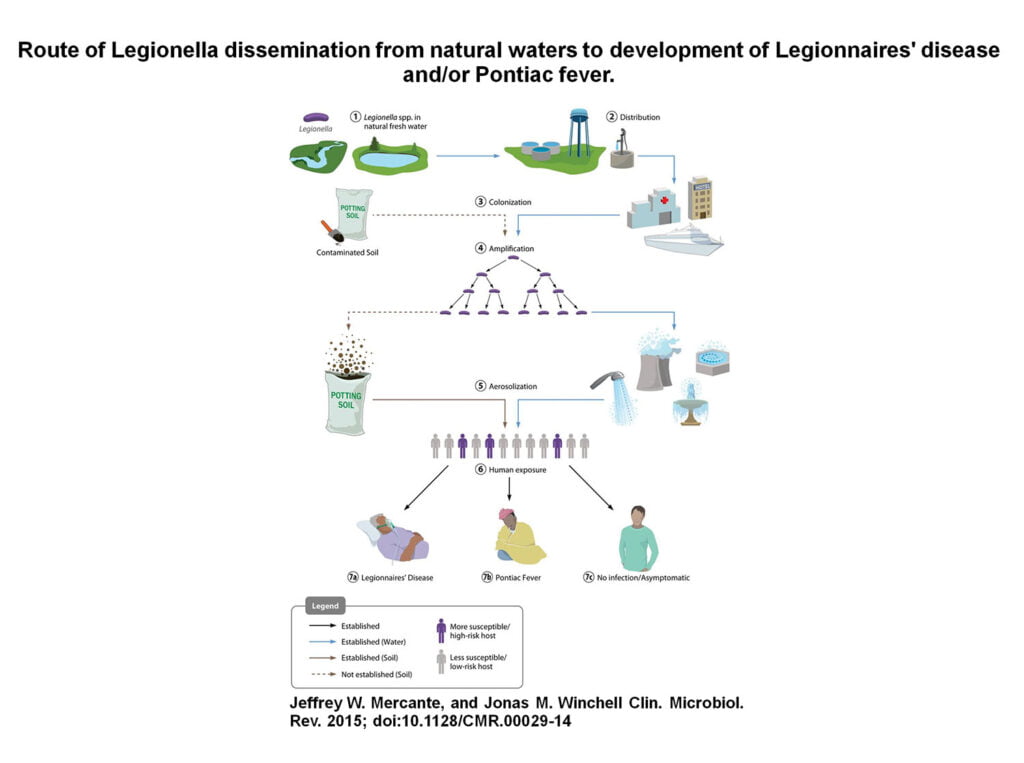Legionella bacteria are difficult to eradicate completely, so prevention takes the form of minimising the concentration of the bacteria in the water and preventing the occurrence of very small droplets.

The temperature of stored water is critical. The optimum temperature for the bacterium to multiply is 37°C, but it ceases at 45°C although it will survive at higher temperatures – a matter of hours at 50°C and a matter of minutes above 60°C. It remains dormant below 20°C. A rise in temperature from the level where it is dormant to that where it is favourable causes active multiplication.
The following actions will help prevent an outbreak of Legionella:
A SYSTEMS AND TANKS
- Systems should be designed with short pipe runs and no ‘dead legs’.
- Tanks should be connected in series to eliminate stagnant water.
- Non-metallic tanks made of fibreglass or rubber tank linings are recommended.
- Cold water should circulate at temperatures below 20°C, and cold water services should not be placed near heat sources.
- Hot water should be stored above 60°C and circulated above 50°C. Calorifiers and hot water pipes should be lagged to ensure that these temperatures are maintained.
- All newly installed pipework for hot or cold water services should be sterilised on commissioning and before being brought into use.
- Inspect storage tanks and calorifiers annually, remove all sludge, scale and sediment and sterilise before bringing back into use.
- Shower heads should be routinely de-scaled and disinfected.
B COOLING TOWERS
- Cooling towers should be sited as far away as possible from air-conditioning and ventilation inlets and from opening windows and occupied areas. They should be constructed to facilitate cleaning and maintenance and use materials which do not promote bacterial growth.
- Cooling systems should have an established water treatment programme to monitor, log and control scale and corrosion. Complementary biocides should be used alternately for weekly shock treatment. Constantly blow-down to limit the concentration of salts.
- Checks for Legionella should be conducted at six-monthly intervals.
- All cooling systems should be stripped down, cleaned and disinfected at least twice a year in addition to regular water treatment.
- Disinfection is generally by chlorination so that a level of at least 20 ppm of free residual chlorine is maintained for a given period in cooling towers and higher levels for storage tanks.
- Particular care is needed when standby supplies are brought into service in case these are themselves contaminated.
C WATER TREATMENT
- Water treatment activities should be carried out only by suitably trained personnel using the appropriate safety equipment. This includes wearing protective clothing and having first aid facilities available. Care should be taken to avoid damage to catering and other equipment which may be affected by the chlorination process.
- Effluent from cleaning and maintenance should be neutralised by a hose and run off to a foul sewer, after having received permission to discharge to sewer from the relevant authorities.
To find out more about Legionella control contact us at [email protected] to discuss your individual requirements.
